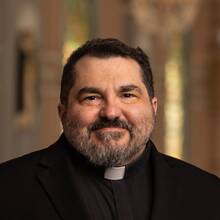Even Deeper Faith
‘This is my beloved Son, with whom I am well pleased; listen to him.’
How can you challenge yourself to deeper faith?
What insight has your faith taught you that you can share with others?
Jesus performs most of his wonders for the good of others. His healings and exorcisms, for example, were free gifts that rekindled the faith of many. The transfiguration is different. At first glance, it seems centered completely on Jesus. A reader can be forgiven for wondering how to apply this narrative to discipleship.
In Matthew’s hands, the transfiguration is a lesson in faith. Matthew sets the event among episodes that highlight the growing faith of the apostles. Not long before, a group of Pharisees and Sadducees challenged Jesus to produce a sign. It is not entirely clear if they were expecting a celestial wonder or some kind of symbolic action like those by Jeremiah (13:1-11) and Ezekiel (4:1-17). Either way, Jesus refuses, pointing out that his sign, like the prophet Jonah’s, was a ministry of preaching the truth.
Matthew relates Peter’s confession of faith not long after that confrontation. His testimony is a dramatic contrast to the challenge of the Pharisees and Sadducees. Peter’s faith had grown so strong that he could believe on the strength of Jesus’ word alone.
The sign of the transfiguration came only after the act of faith. Peter along with James and John (who presumably shared Peter’s faith) saw Jesus as he appears in the Father’s eyes. They saw the incarnate Son who fulfilled the prophecy of Daniel we hear in the first reading. Jesus shared the Father’s glory and was the Word that inspired Moses and Elijah. Peter’s faith in Jesus was confirmed in spectacular fashion.
“This is my beloved Son. Listen to him.” Throughout Matthew’s Gospel, faith is something that either grows or dies. The word of God had found deep, fertile soil within Peter, James and John. It grew in their hearts to such an extent that they too came to hear the voice that inspired Jesus himself.
The results of the transfiguration appear in the second reading, which was probably written not by Peter but by someone close to him. The author reflects on Peter’s faith through the lens of the growing Christian movement. Today we would call such writing a study in Petrine spirituality. The author points specifically to the transfiguration as the event that gave Peter the confidence to propagate the message of Christ. Peter’s act of faith transformed him and allowed him to lead others to a similar transformation.
By putting our faith in the same message, we too can make ourselves sensitive to God’s word. Though we may sometimes struggle, if we continue to deepen our faith, we can help all humanity hear the voice of God.
This article also appeared in print, under the headline “Even Deeper Faith ,” in the July 24,2017, issue.







